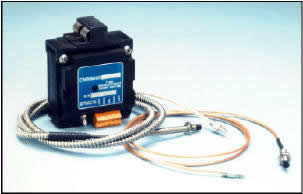 Sales
Technology offers the SKF Condition Monitoring line of Eddy
Probe Systems Sales
Technology offers the SKF Condition Monitoring line of Eddy
Probe Systems
CMSS62
19 mm System
CMSS65
5 mm System
CMSS68
8 mm System
Applications:
Often
seismic transducers are not the best sensor for monitoring
vibration on specific machines. Eddy probes offer a solution
to most of the problems inhibiting the use of traditional
seismic sensors. The most common use of eddy current probes
is for journal type bearings. Journal bearings behave different
than rolling element bearings in that they do not transmit
the vibration of the shaft into the bearing cap due to the
damping properties of this type of bearing. Another application
for eddy probes, is where a high case to rotor weight ratio
exists (turbines and compressors). In these applications most
of the shaft's vibration energy is dissipated as displacement,
which can only be measured by shaft relative motion.
Frequency
considerations also exist with eddy probes. While eddy probes
have no lower frequency limit, very high frequencies become
a problem. An eddy probe senses displacement, and at high
frequencies displacement is often quite small requiring the
use of a seismic accelerometer.
How Eddy
Probes Work:
An eddy
probe system consists of a probe, matched extension cable,
and driver (oscillator demodulator). The tip of the probe
contains an encapsulated wire coil which radiates the driver's
high frequency as a magnetic field. When a conductive surface
comes into close proximity to the probe tip, eddy currents
are generated on the target surface decreasing the magnetic
field strength, leading to a decrease in the driver's DC output.
This DC output is usually 200mV/mil or in a similar range.
This signal is then sent to a CMCP 500 Series Transmitter
or Monitor for conversion into a 4-20 mA output relative to
displacement (CMCP540 and 540A) or position (CMCP545 and 545A).
The CMCP540A and CMCP545A Monitors allow programmable alert
and danger alarms with relays for the eddy probe driver's
signal.

|




 Sales
Technology offers the SKF Condition Monitoring line of Eddy
Probe Systems
Sales
Technology offers the SKF Condition Monitoring line of Eddy
Probe Systems











